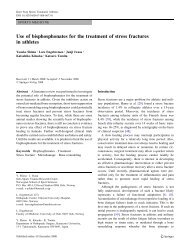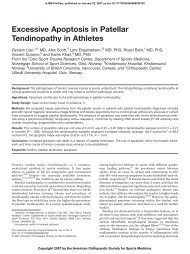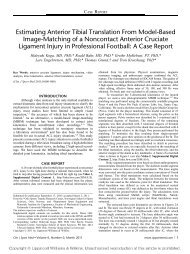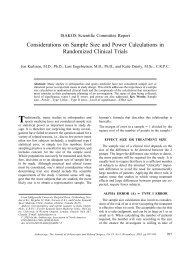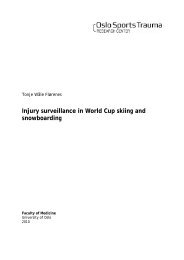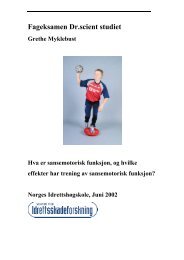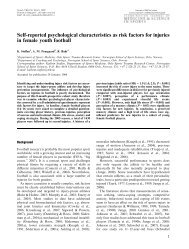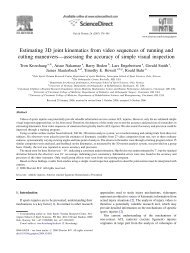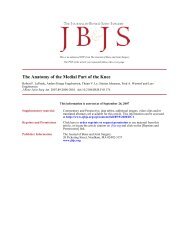ECSS Position Statement 2009: Prevention of acute sports injuries
ECSS Position Statement 2009: Prevention of acute sports injuries
ECSS Position Statement 2009: Prevention of acute sports injuries
Create successful ePaper yourself
Turn your PDF publications into a flip-book with our unique Google optimized e-Paper software.
232 K. Steffen et al.<br />
Downloaded By: [Steffen, Kathrin] At: 02:55 10 June 2010<br />
efficacious interventions. This, in turn, requires<br />
knowledge about the implementation context including<br />
how people, their attitudes and safety (or<br />
risk) behaviours interact with these interventions<br />
(Finch & Donaldson, <strong>2009</strong>). In other words, true<br />
injury prevention can only be achieved if some form<br />
<strong>of</strong> behavioural change can be invoked in all individuals<br />
involved in an athlete’s safety and health,<br />
including coach, referee, and the athlete him or<br />
herself. A number <strong>of</strong> the <strong>acute</strong> <strong>injuries</strong> observed may<br />
be prevented if athletes participate in <strong>sports</strong> within<br />
the limits <strong>of</strong> their personal qualifications, physical<br />
condition, and avoid risky situations. Therefore, one<br />
<strong>of</strong> the major goals should be to establish injury<br />
prevention habits early in life.<br />
Equipment<br />
Helmets have been introduced in skiing, snowboarding,<br />
horse riding, ice hockey, cycling, and baseball.<br />
In some <strong>sports</strong>, their use is strongly recommended;<br />
in others, helmets are compulsory when competing.<br />
In <strong>sports</strong> in which falls and collisions are part <strong>of</strong> the<br />
game, elbow and shoulder pads are expected to<br />
reduce upper extremity injury risk. Similarly, wrist<br />
guards are effective in protecting against wrist<br />
<strong>injuries</strong>, at least in snowboarding. However,<br />
although such external prophylactic measures are<br />
shown to be efficacious, a true reduction <strong>of</strong> injury<br />
risk requires the equipment to be used by the athlete.<br />
Fair play and rules <strong>of</strong> the game<br />
Many <strong>of</strong> the rules and regulations that govern <strong>sports</strong><br />
have been put in place to protect the health <strong>of</strong> the<br />
athlete. Coaches and athletes have a responsibility to<br />
play by the rules (fair play), and referees are<br />
responsible for penalizing behaviour known to cause<br />
<strong>injuries</strong>. Appropriate referee training emphasizing<br />
the safety aspects <strong>of</strong> the rules is important. Decisions<br />
to change rules can be used actively in making the<br />
sport safer for athletes, and such rule changes can<br />
follow from systematic analyses <strong>of</strong> injury mechanisms.<br />
Examples include checking from behind in ice<br />
hockey, holding <strong>of</strong> the arm in team handball, and<br />
elbowing the opponent’s head/neck when heading in<br />
soccer.<br />
Exercise/training<br />
The benefits <strong>of</strong> preventive exercise training on lower<br />
limb injury risk have been documented in several<br />
trials. There is conclusive evidence that neuromuscular<br />
training assists in the reduction <strong>of</strong> ankle and<br />
knee ligament <strong>injuries</strong>, and that eccentric strength<br />
training can prevent muscular strains <strong>of</strong> the hamstrings<br />
and groin.<br />
Comprehensive neuromuscular training programmes<br />
combining plyometrics, strength, balance,<br />
sport-specific technique, and agility exercises can<br />
improve biomechanical measures related to lower<br />
extremity injury risk (Hewett et al., 2006a,b; Myer,<br />
Ford, & Hewett, 2004). While training preventive<br />
exercises, emphasis should be placed on a proper<br />
landing technique, a s<strong>of</strong>t landing on the forefoot,<br />
and engaging knee and hip flexion upon landing. A<br />
two-foot landing is encouraged whenever possible.<br />
In cutting and landing manoeuvres, athletes should<br />
avoid excessive dynamic valgus <strong>of</strong> the knee, always<br />
aiming for the ‘‘knee-over-toe position’’.<br />
Proper rehabilitation <strong>of</strong> the index injury. The strong<br />
association observed between previous <strong>injuries</strong>, reduced<br />
muscle- and joint-specific function, and the<br />
risk for recurrent <strong>injuries</strong> suggests that secondary<br />
prevention <strong>of</strong> re-injury should be emphasized. It is <strong>of</strong><br />
major importance to identify players with previous<br />
<strong>injuries</strong>, impaired neuromuscular control, and functional<br />
deficits to provide optimal treatment and to<br />
prevent further <strong>injuries</strong>. As is true for all <strong>injuries</strong>, it is<br />
important to provide an appropriate rehabilitation<br />
programme and enough time to allow the athlete to<br />
become symptom-free before returning to play<br />
(Hägglund et al., 2006; Myklebust & Bahr, 2005;<br />
Steffen et al., 2008a). An athlete who is not able to<br />
train without pain or other symptoms from a<br />
particular body part should be advised to undergo<br />
rehabilitation and restrict participation in competitions,<br />
as this probably will increase the risk for a<br />
new injury. Hägglund and colleagues (Hägglund,<br />
Waldén, & Ekstrand, 2007) have developed a<br />
10-step rehabilitation programme that serves as<br />
return-to-play guidelines for soccer players, which<br />
has been shown to be effective in preventing re-injury.<br />
Start early and identify athletes at risk. One goal in<br />
<strong>sports</strong> injury prevention is to teach athletes less<br />
vulnerable movement patterns, which may be easier<br />
to accomplish with young athletes who have not yet<br />
established their basic motion patterns. We therefore<br />
suggest that programmes to improve basic movement<br />
skills and strength, awareness, and neuromuscular<br />
control <strong>of</strong> static and dynamic movements be<br />
implemented in physical education curricula in<br />
schools and in youth <strong>sports</strong> clubs.<br />
Implementation, establishment <strong>of</strong> routines, and<br />
maintenance. How much risk is reduced depends<br />
on compliance with the exercise programme (Soligard<br />
et al., 2008), as the compliance <strong>of</strong> coaches and



